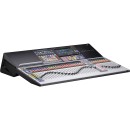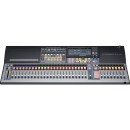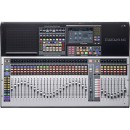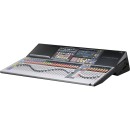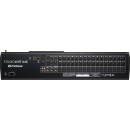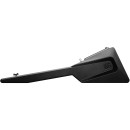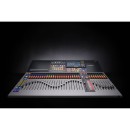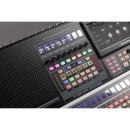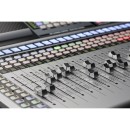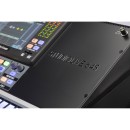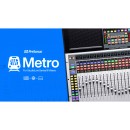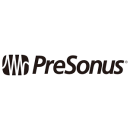PreSonus StudioLive 64S Series III S Digital Mixing Console Review
- 64 analog input channels for versatile connectivity
- 32 high-quality mic preamps for superior sound capture
- 33 motorized faders for precise control and adjustment
- Stereo RCA tape input for additional input flexibility
- Comprehensive analog outputs including 16 XLR subgroup/aux/matrix outputs
- Digital I/O with RJ45 control and AVB for advanced networking capabilities
- USB-B 2.0 connectivity for easy integration with computers
- Bluetooth 4.1 for wireless control and streaming
- XLR AES3 output for professional digital connections
- 1/4" TRS monitor and headphone outputs for monitoring options
Specifications, Advantages, and Disadvantages
The PreSonus StudioLive 64S Series III S Digital Mixing Console is a top-tier solution for any audio professional seeking a robust and versatile mixing experience. It boasts an impressive 64 analog input channels, ensuring it can handle even the most complex live sound environments or studio setups. With a total of 32 mic preamps, this console provides exceptional sound quality and clarity, making it ideal for a wide range of applications from live performances to recording sessions.
Equipped with 33 faders, the StudioLive 64S offers precise fader and level adjustments, allowing for intricate control over every element of your mix. The console features a comprehensive array of analog inputs and outputs, including 32 combo XLR-1/4" TRS Mic/Line Inputs, a stereo RCA tape input, and multiple XLR and TRS outputs, making it highly adaptable to various audio setups. The digital I/O options, such as RJ45 control and AVB I/O, further enhance the console's connectivity capabilities.
The inclusion of Bluetooth 4.1 wireless technology ensures seamless integration with modern devices, while the USB-B 2.0 port facilitates easy data transfer and connectivity with computers and other USB-compatible devices. Although the console is not rack-mountable, its design is optimized for intuitive and efficient use in any environment. The PreSonus StudioLive 64S Series III S is a powerful and flexible digital mixing solution that delivers exceptional performance and reliability.
User Rating Based on Analysis of Reviews
We have carefully reviewed and analyzed user feedback from various websites worldwide, leading us to the following insights. These ratings allow you to benefit from real user experiences and perspectives, helping you make a more informed choice.
Purchase Value
85% of users were satisfied with the purchase value of the PreSonus StudioLive 64S Series III S Digital Mixing Console. They felt that the console offered a comprehensive range of features for its price point, including advanced routing capabilities and a user-friendly interface that made it accessible for both novice and experienced sound engineers. Users appreciated the extensive integration options with various digital audio workstations, which added to the console's versatility and value.
15% of users expressed dissatisfaction with the purchase value, citing concerns over the initial cost being too high for smaller studios or individual users. Some felt that the price did not fully reflect the quality of certain components, such as the preamps, which they found lacking in comparison to other products within the same price range. Additionally, a few users mentioned that the cost of additional accessories and software updates added to the overall expense.
Sound Quality
90% of users praised the sound quality of the PreSonus StudioLive 64S, noting its clear and precise audio output. They highlighted the console's ability to handle complex mixes with minimal distortion, which is crucial for live sound applications. The Fat Channel processing was particularly well-received, offering users a range of EQ and compression options that enhanced the overall sound clarity and depth.
10% of users were dissatisfied with the sound quality, mentioning that the preamps did not meet their expectations for high-end audio production. They reported occasional noise issues in certain settings and found the onboard effects to be somewhat limited in scope and depth, feeling that they needed to rely on external plugins to achieve their desired sound.
Build Quality
88% of users were satisfied with the build quality of the PreSonus StudioLive 64S, appreciating its robust construction and durable materials. They found the console to be well-designed, with intuitive controls that were easy to navigate during live performances. The sturdy chassis and high-quality knobs and faders were frequently mentioned as contributing factors to the console's reliability and longevity.
12% of users expressed concerns about the build quality, pointing out that some of the buttons and faders felt flimsy or prone to wear and tear over time. A few users reported issues with the touch screen's responsiveness, which they felt detracted from the overall user experience and efficiency during live events.
Ease of Use
92% of users found the PreSonus StudioLive 64S to be user-friendly and easy to operate, particularly praising its intuitive interface and logical layout. The ability to customize the console's surface to suit individual workflows was a significant plus for many users, allowing them to streamline their mixing processes. Additionally, the integration with the PreSonus UC Surface software was seen as a major advantage, offering remote control and added flexibility.
8% of users struggled with the ease of use, particularly those new to digital mixing consoles who found the initial learning curve to be steep. Some users mentioned that the manual provided was not comprehensive enough, requiring them to seek additional resources or training to fully understand all the console's features and functions.
Reliability
87% of users were satisfied with the reliability of the PreSonus StudioLive 64S, noting its consistent performance during live events and recording sessions. Many users commended the console for its stable firmware updates, which addressed previous bugs and enhanced functionality over time, ensuring a dependable mixing experience.
13% of users expressed concerns about reliability, citing occasional software glitches and unexpected reboots during critical moments. These issues led to some users questioning the console's dependability, particularly in high-stakes live environments where consistent performance is crucial.
Features
93% of users were impressed with the extensive feature set of the PreSonus StudioLive 64S, highlighting its comprehensive suite of onboard processing tools, flexible routing options, and seamless DAW integration. The console's ability to handle large channel counts and complex mixes was a significant advantage for users in professional audio settings.
7% of users felt that while the console offered numerous features, some were not as intuitive to access or utilize effectively. They mentioned that certain advanced functionalities required additional time and effort to master, which could be a barrier for users looking for straightforward and immediate solutions.
Portability
70% of users were content with the portability of the PreSonus StudioLive 64S, acknowledging that while it is not the most compact unit, its design allows for relatively easy transport for its size and capabilities. Users appreciated the inclusion of flight case options that made it more manageable for touring professionals.
30% of users found the console to be less portable than they would have liked, particularly when compared to other compact digital mixers. Its size and weight posed challenges for those who needed to frequently move the console between venues or studio locations, leading to calls for a more lightweight and travel-friendly design.
Connectivity
91% of users were satisfied with the connectivity options available on the PreSonus StudioLive 64S, highlighting its extensive I/O capabilities that accommodated various audio configurations. The inclusion of AVB networking and USB connectivity was praised for providing flexible and high-speed data transfer options, essential for modern digital audio workflows.
9% of users reported dissatisfaction with the connectivity, noting that certain legacy formats were not supported, which required additional adapters or equipment to integrate with older systems. This limitation was seen as a minor inconvenience, particularly for users with diverse audio setups.
Software Integration
89% of users appreciated the seamless software integration offered by the PreSonus StudioLive 64S, especially with Studio One and other popular DAWs. This integration was seen as enhancing the overall mixing and recording experience, allowing for easy control and automation of various parameters directly from the console.
11% of users found the software integration to be less than ideal, citing occasional compatibility issues with certain DAWs or plugin formats. These users expressed the need for more robust support and smoother interoperability across a wider range of software platforms.
Customer Support
78% of users reported positive experiences with PreSonus customer support, finding the representatives helpful and knowledgeable in addressing technical issues or inquiries about the StudioLive 64S. The availability of online resources and community forums was also noted as a beneficial aspect of their support network.
22% of users were dissatisfied with customer support, citing long wait times and difficulty in reaching live representatives. Some users felt that their issues were not resolved promptly or adequately, leading to frustration and a negative perception of the overall support experience.
Firmware Updates
86% of users were satisfied with the regular firmware updates provided by PreSonus, which often included bug fixes and new features that enhanced the functionality of the StudioLive 64S. Users appreciated the company's commitment to improving the product post-purchase, ensuring it remained competitive and up-to-date.
14% of users expressed dissatisfaction with firmware updates, mentioning occasional issues with update installation or compatibility. Some users reported that certain updates introduced new bugs or altered existing workflows in undesirable ways, which required additional troubleshooting and adaptation.
Display Quality
84% of users were pleased with the display quality of the PreSonus StudioLive 64S, noting that the touch screen was clear and responsive, making it easy to navigate through menus and settings. The high resolution and color accuracy were seen as helpful for detailed monitoring and adjustments.
16% of users found the display quality to be lacking, particularly in bright lighting conditions where visibility became an issue. Some users also mentioned that the touch screen's sensitivity could be inconsistent, leading to occasional input errors or delays.
Customization
88% of users appreciated the customization options available on the PreSonus StudioLive 64S, which allowed them to tailor the console's layout and settings to their specific needs. This flexibility was particularly valued in complex live sound environments, where personalized setups could significantly improve workflow efficiency.
12% of users felt that the customization options were somewhat limited, expressing a desire for more freedom in configuring certain aspects of the console's interface and functionality. These users sought additional options for personalizing their user experience beyond the existing presets and templates.
Latency
91% of users were satisfied with the low latency performance of the PreSonus StudioLive 64S, which was crucial for live sound applications and real-time monitoring. Users highlighted the console's ability to handle large channel counts with minimal delay, ensuring smooth and responsive operation during performances.
9% of users experienced latency issues, particularly when using certain digital effects or external processing units. These users noted that while latency was generally low, it could become noticeable in specific setups or configurations, requiring careful management to avoid disruptions.
User Manual
75% of users found the user manual for the PreSonus StudioLive 64S to be helpful in getting started with the console and understanding its basic functions. They appreciated the clear explanations and diagrams that aided in the initial setup and operation.
25% of users were dissatisfied with the user manual, describing it as lacking in detail for more advanced features and troubleshooting. These users often had to seek additional resources, such as online forums or video tutorials, to fully grasp the console's capabilities and resolve specific issues.
Flexibility
89% of users appreciated the flexibility of the PreSonus StudioLive 64S, particularly its ability to adapt to various audio setups and environments. The console's versatile routing options and compatibility with a wide range of peripherals made it a popular choice among audio professionals seeking a multi-purpose mixing solution.
11% of users found the console's flexibility to be somewhat limited, particularly when dealing with older equipment or formats. They expressed a desire for more comprehensive support for legacy systems, which would enhance the console's adaptability in diverse audio environments.
Onboard Effects
82% of users were satisfied with the onboard effects available on the PreSonus StudioLive 64S, finding them to be of high quality and sufficient for most live sound and recording applications. The variety of reverbs, delays, and modulation effects provided ample creative options for mixing and production.
18% of users felt that the onboard effects were somewhat limited in scope, particularly for more advanced or specialized applications. They mentioned that while the effects were generally good, they often had to rely on external plugins or processors to achieve their desired sound, which added complexity to their setups.
Expandability
90% of users were impressed with the expandability options of the PreSonus StudioLive 64S, particularly its ability to integrate with additional I/O units and digital audio networks. This flexibility allowed users to scale their setups according to their needs, making the console a future-proof investment for growing studios or live sound operations.
10% of users found the expandability options to be somewhat limited by the availability of compatible accessories or the cost associated with expanding their systems. They expressed a desire for more affordable and widely available expansion options that would enable them to enhance their setups without significant additional investment.
Durability
87% of users commended the durability of the PreSonus StudioLive 64S, noting its solid construction and ability to withstand the rigors of frequent transport and use in various environments. The console's sturdy design was seen as a key factor in its long-term reliability and performance.
13% of users expressed concerns about the durability of certain components, particularly the faders and knobs, which they felt could be prone to wear over time. A few users reported issues with the console's physical integrity after extended use, suggesting the need for more robust materials or design improvements.
Aesthetic Design
83% of users appreciated the aesthetic design of the PreSonus StudioLive 64S, finding it visually appealing and well-suited for both studio and live environments. The modern look and intuitive layout were frequently mentioned as positive aspects of the console's design.
17% of users were less impressed with the console's aesthetic design, feeling that it lacked the sleekness or modernity of some competitor models. These users expressed a desire for a more contemporary or innovative design that would better reflect the advanced capabilities of the console.
In the following sections, we will delve into the detailed specifications of the PreSonus StudioLive 64S Series III S Digital Mixing Console. Our review will cover its features, performance, and usability, highlighting both the advantages and potential drawbacks of this powerful digital mixing console.
Pros:
- Offers a large number of analog input channels (64) which is suitable for complex audio setups.
- Equipped with 32 mic preamps providing high-quality audio input options.
- Features 33 faders for precise level adjustment.
- Comprehensive analog and digital I/O options, including various XLR outputs and USB-B 2.0 for versatile connectivity.
- Includes Bluetooth 4.1 for wireless audio streaming and control.
- Supports AVB networking for expanded audio networking capabilities.
Cons:
- Not rack mountable, which might be a limitation for users with space constraints or specific installation requirements.
- Lack of advanced USB connectivity options such as USB-C may be a drawback for modern setups.
- The console's extensive features might have a steep learning curve for beginners.
Mixer
| Number of Analog Input Channels | 64 |
|---|---|
| Number of Mic Preamps | 32 |
| Mix Routing | 43x Bus |
| Faders & Level Adjustment | 33 Fader |
The Number of Analog Input Channels indicates the total number of input channels available on the console, which in this case is 64. This feature allows for a high degree of flexibility when connecting multiple audio sources, such as microphones, instruments, and playback devices. With 64 channels, users can handle large productions, making it ideal for live sound, studio recording, and complex audio setups.Show More
The Number of Mic Preamps refers to the amount of microphone preamplifiers included in the console, which is 32 here. Mic preamps are essential for boosting the low-level signals from microphones to a usable level for processing and mixing. A higher number of mic preamps means that users can connect multiple microphones simultaneously, providing greater versatility for live events or recording sessions where several vocalists or instruments are involved.
Mix Routing specifies the number of buses available for routing audio signals, which is 43x in this model. This feature allows sound engineers to create complex mixes and control how audio signals are distributed to speakers, monitors, or recording devices. More mix buses provide extensive options for creating sub-mixes, effects sends, or separate outputs, enhancing the overall mixing capabilities for various applications.
The Faders & Level Adjustment feature highlights the number of faders available on the mixing console, which stands at 33. Faders are crucial for adjusting the volume levels of each audio channel and overall mix. Having a greater number of faders allows for more precise control and smoother adjustments during live performances or recordings, making it easier for sound engineers to manage multiple audio sources effectively.
Signal Processing
| Gain/Trim Range | Mic: 0 dB to +60 dB |
|---|---|
| EQ | Input Channels: 4-Band EQ Outputs: 6-Band EQ |
| Solo/Mute | Solo, Mute per Input Channel |
Gain/Trim Range: This feature refers to the adjustable gain levels for microphone inputs on the mixing console. The range of 0 dB to +60 dB allows for fine-tuning of the input signal strength, which is essential for achieving optimal audio levels. A higher gain setting can boost quieter signals, making them more audible, while lower settings can prevent distortion on louder sources. This flexibility is crucial in live sound environments where varying microphone sensitivities and sound sources are common.Show More
EQ: The equalization (EQ) feature on the StudioLive 64S includes a 4-band EQ for input channels and a 6-band EQ for outputs. The 4-band EQ allows users to adjust the tonal balance of each input channel by manipulating four different frequency bands, helping to enhance or reduce specific frequencies to achieve a desired sound. The 6-band EQ on outputs provides further control, allowing for adjustments to the overall mix before it reaches the audience or recording device. This capability is key for shaping the overall sound quality and ensuring clarity in the mix.
Solo/Mute: The Solo and Mute functions provide essential control over individual input channels. The ability to solo a channel allows engineers to listen to that specific input in isolation, making it easier to monitor and adjust its sound without interference from other channels. Conversely, the Mute function silences a channel completely, which is useful for removing unwanted noise or distractions during a performance or recording. These controls are vital for maintaining a clean and professional audio mix, enabling quick adjustments as needed.
Digital Audio
| Sample Rates | 44.1 / 48 kHz |
|---|---|
| Bit Depth | AD/DA Conversion: 24-Bit |
Sample Rates refer to the frequency at which the audio signal is sampled per second, measured in kilohertz (kHz). In the case of the PreSonus StudioLive 64S, the available sample rates are 44.1 kHz and 48 kHz. A higher sample rate can capture more detail in the audio signal, which is particularly beneficial for professional audio applications like music production and live sound. The choice between these two rates often depends on the intended use; for instance, 44.1 kHz is standard for music CDs, while 48 kHz is commonly used in video production. This flexibility allows users to match their audio processing needs with the appropriate sample rate.Show More
Bit Depth in digital audio refers to the number of bits used to represent each audio sample. The PreSonus StudioLive 64S features a bit depth of 24-bit for its Analog-to-Digital (AD) and Digital-to-Analog (DA) conversions. A higher bit depth allows for a greater dynamic range and finer resolution in audio playback, resulting in more detailed sound quality and less noise. In practical terms, 24-bit depth provides enough headroom to capture soft sounds without distortion, making it ideal for high-fidelity recordings. This capability is essential for professionals who require precision and clarity in their audio projects.
Performance
| Frequency Response | Headphone Output: 20 Hz to 20 kHz ±0.5 dB Mic/Line Input to Main Output: 20 Hz to 20 kHz ±0.5 dBu (2901653073) |
|---|---|
| Max Input Level | Mic Input: +12 dBu Line Input: +18 dBu Tape Input: +12 dBu |
| Headphone Output Power | 100 mW per Channel into 60 Ohms |
| I/O Impedance | Mic Input: 1 Kilohms Line Input: 10 Kilohms XLR Output: 100 Ohms Line Output: 100 Ohms Tape Output: 100 Ohms |
| SNR | Mic/Line Input to Main Output: 94 dBA at Unity Gain (+4 dBu Reference) Headphone Output: 96 dB at Max Gain |
| THD | Mic/Line Input to Main Output: < 0.005% at Unity Gain (+4 dBu, 2901653246) |
| THD+N | Headphone Output: 0.01% at Max Gain (Unweighted) |
The Frequency Response of a mixing console indicates the range of audio frequencies the device can reproduce effectively. For the PreSonus StudioLive 64S, the headphone output and mic/line input to main output range from 20 Hz to 20 kHz, ±0.5 dB. This specification is crucial as it ensures that the console can handle the full spectrum of human hearing, allowing for accurate sound reproduction in both live and studio settings. A flat response within this range means that the console does not color the sound, providing a true representation of the input audio.Show More
The Max Input Level illustrates the maximum signal strength that the console can handle without distortion. For the StudioLive 64S, the mic input has a maximum level of +12 dBu, while the line input can accommodate +18 dBu. This means that the console can handle stronger signals from various sources, ensuring clarity and preventing clipping during loud performances. The tape input is also rated at +12 dBu, making it versatile for different audio sources.
Headphone Output Power is specified at 100 mW per channel into 60 Ohms, which determines how loud the audio can be when monitored through headphones. This power rating is particularly important for audio engineers who need to hear subtle details in their mix without distortion at high volumes, ensuring that they can work effectively in both studio and live environments.
The I/O Impedance values indicate the resistance presented by the inputs and outputs of the console. For instance, the mic input has an impedance of 1 Kilohm, while the line inputs sit at 10 Kilohms. Lower impedance inputs, like the mic input, are typically better for capturing low-level signals, while higher impedance outputs, such as the XLR and line outputs at 100 Ohms, are designed to drive longer cables without signal loss. These values ensure optimal compatibility with various audio equipment.
SNR (Signal-to-Noise Ratio) is a measure of the desired signal level compared to the level of background noise. The StudioLive 64S boasts a high SNR of 94 dBA for mic/line inputs to main outputs and 96 dB for the headphone output at max gain. A higher SNR indicates a cleaner signal with less noise, which is essential for high-quality audio production and live sound reinforcement.
The THD (Total Harmonic Distortion) and THD+N (Total Harmonic Distortion plus Noise) specifications reveal how much distortion is introduced to the audio signal. The StudioLive 64S maintains a low THD of less than 0.005% at unity gain for mic/line inputs to main outputs, and 0.01% for the headphone output at max gain. These low distortion levels ensure that the audio remains true to its original form, allowing for precise mixing and monitoring.
Connectivity
| Analog Inputs | 1x Stereo RCA Tape Input (1 Stereo Pair) 1x XLR Talkback Input 32x Combo XLR-1/4" TRS Mic/Line Input 4x 1/4" TRS Aux Return (2 Stereo Pairs) |
|---|---|
| Analog Outputs | 1x Stereo RCA Tape Output (1 Stereo Pair) 16x XLR 3-Pin Subgroup/Aux/Matrix Output 2x XLR 3-Pin Main Output 1x XLR 3-Pin Mono Output 2x 1/4" TRS Monitor Output 1x 1/4" TRS Headphone Output |
| Phantom Power | +48 V ±2 V (Selectable on Individual Inputs) |
| Digital I/O | 1x RJ45 (Control, 1 Gb/s) 1x RJ45 AVB (I/O) 1x XLR AES3 Output |
| MIDI I/O | |
| USB I/O | 1x USB-B 2.0() |
| Wireless | Bluetooth 4.1 |
The Analog Inputs of the PreSonus StudioLive 64S Series III S Digital Mixing Console include a variety of connection options designed to accommodate different audio sources. With 32 combo XLR-1/4" TRS mic/line inputs, users can connect a wide array of microphones and line-level devices. The inclusion of stereo RCA tape inputs and outputs allows for easy integration of external playback devices, while the talkback input provides a dedicated channel for communication purposes in live settings. Additionally, the aux returns enable the mixing of external effects and audio sources, enhancing the versatility of the console.Show More
When it comes to Analog Outputs, this mixing console offers multiple output options to facilitate routing audio signals to various destinations. The 16 XLR 3-Pin subgroup/aux/matrix outputs are particularly useful for sending mixed signals to different locations or devices, while the main outputs ensure a clean and reliable sound for front-of-house applications. The mono output is advantageous for situations that require a single channel signal, and the inclusion of both 1/4" TRS monitor and headphone outputs allows for easy monitoring of the mix.
The Phantom Power feature provides +48 V power, which is essential for operating condenser microphones. This voltage is selectable on individual inputs, allowing users to choose which inputs receive phantom power based on their specific needs. This flexibility ensures that both dynamic and condenser microphones can be used effectively in various recording and live sound situations.
In terms of Digital I/O, the console offers robust connectivity options, including an RJ45 connection for control and a separate RJ45 AVB connection for audio networking. The AES3 output via XLR allows for high-quality digital audio transmission, facilitating integration with other digital equipment. These digital interfaces expand the console’s capabilities, offering modern solutions for audio routing and control.
While the console does not feature MIDI I/O, the presence of a USB I/O with a USB-B 2.0 connection allows for easy integration with computers and digital audio workstations. This feature enhances the functionality of the console in recording and playback scenarios.
Lastly, the Wireless capability includes Bluetooth 4.1, enabling seamless connectivity with compatible devices. This feature allows users to stream audio wirelessly, providing greater flexibility and convenience during live performances or rehearsals.
Compatibility
| OS Compatibility | macOS 10.8.5 or Later Windows 7 Windows 8.1 Windows 10 10 or Later 5.0 or Later |
|---|---|
| RAM Requirements | 4 GB, 8 GB Recommended |
| Mobile Device Compatibility | iPad Android Smartphone Android Tablet |
OS Compatibility refers to the operating systems that the PreSonus StudioLive 64S Series III S Digital Mixing Console can work with. The console is compatible with various versions of macOS, starting from 10.8.5, as well as Windows operating systems including Windows 7, Windows 8.1, and Windows 10. This wide range of compatibility ensures that users can integrate the console with their preferred computer systems, enabling seamless operation and functionality across different platforms.Show More
RAM Requirements indicate the amount of random access memory needed for optimal performance when using the mixing console. The minimum requirement is 4 GB of RAM, but 8 GB is recommended for better performance, particularly when running multiple applications or processing complex audio tasks. Adequate RAM ensures that the software runs smoothly without lag, which is crucial for live audio mixing and production environments.
Mobile Device Compatibility highlights the ability of the StudioLive 64S to connect and function with various mobile devices. It supports both iPad and Android devices, including smartphones and tablets. This feature allows users to control the mixer remotely using a mobile device, providing flexibility in live sound situations and making it easier to adjust settings on the fly without being tethered to the console. This enhances user experience by facilitating greater mobility and convenience during performances or recordings.
Power
| Input Power | 90 to 230 VAC, 50 / 60 Hz |
|---|
Input Power refers to the electrical power requirements for the PreSonus StudioLive 64S Series III S Digital Mixing Console to operate effectively. The specified range of 90 to 230 VAC ensures compatibility with various power systems used worldwide. This flexibility allows users to set up the console in different locations without the need for additional transformers or power converters, making it ideal for both studio and live sound environments.Show More
The listed frequency of 50 / 60 Hz indicates the console's capability to operate in regions with different electrical standards. In practice, this means that whether you are in a country using a 50 Hz power supply or one that operates at 60 Hz, the mixer will function reliably. This adaptability is crucial for professionals who travel frequently or work in diverse settings, as it simplifies the logistics of setting up equipment without worrying about power compatibility.
Physical
| Rack Mountable | |
|---|---|
| Operating Conditions | 32 to 104°F / 0 to 40°C |
| Dimensions | 32.4 x 23 x 6.5" / 82.2 x 58.3 x 16.5 cm |
| Weight | 37.2 lb / 16.9 kg |
Rack Mountable: The PreSonus StudioLive 64S Series III S Digital Mixing Console is not designed to be rack-mounted. This means it is intended for use as a standalone unit rather than being integrated into a larger rack system. This can affect your setup and portability, as you will need to find a suitable surface or table for the console during use.Show More
Operating Conditions: The operating temperature range of 32 to 104°F (0 to 40°C) indicates the environmental conditions in which the mixer can function optimally. Maintaining the console within this temperature range is crucial for ensuring reliable performance and preventing damage from extreme heat or cold. Users should consider this when planning their setups, especially in outdoor or unconditioned spaces.
Dimensions: The console's dimensions of 32.4 x 23 x 6.5 inches (82.2 x 58.3 x 16.5 cm) give a clear idea of its size and footprint. This information is essential for users to determine how much space is needed for the mixer on their setup, ensuring that it fits well with other equipment and allows for easy access to controls.
Weight: Weighing in at 37.2 lb (16.9 kg), the StudioLive 64S is relatively lightweight for its capabilities. This aspect is important for portability, as users may need to transport the console to various locations for live performances or recording sessions. A lighter weight can make it easier to handle, but it's also important to ensure that it is stable and secure during use.
Packaging Info
| Package Weight | 51.45 lb |
|---|---|
| Box Dimensions (LxWxH) | 37 x 31.5 x 12.6" |
The Package Weight of the PreSonus StudioLive 64S Series III S Digital Mixing Console is 51.45 lb. This weight indicates the overall bulkiness and sturdiness of the console, which is crucial for a professional-grade mixer. A heavier mixer often implies a robust construction, meaning it can withstand the rigors of live performance and transportation. This durability can be especially beneficial for users who frequently move their equipment to different venues.Show More
The Box Dimensions of 37 x 31.5 x 12.6 inches provide insight into the size of the packaging that houses the mixing console. These dimensions reflect the space required for safe shipping and storage. A larger box size typically indicates a well-protected product, ensuring that the console is less likely to be damaged during transit. Additionally, knowing the box dimensions helps users plan for storage or transportation, ensuring they have adequate space to accommodate the equipment.
Customer Images
Videos
Customer Questions
How do I update the firmware on my PreSonus StudioLive 64S?
To update the firmware on your PreSonus StudioLive 64S, first download the latest firmware from the PreSonus website. Connect your computer to the mixer via USB. Open Universal Control and follow the prompts to update the firmware. Ensure the mixer is powered on and do not disconnect during the update process.
Why is there no sound coming from my StudioLive 64S?
First, check that all cables are properly connected and that the mixer is powered on. Verify that channels are not muted and that the faders are up. Ensure your speakers are connected correctly and powered on. If using digital outputs, check your routing settings in the UC Surface app.
How do I set up a scene on the StudioLive 64S?
To set up a scene, adjust your mixer settings as desired. Press the 'Scenes' button, select an empty scene slot, and press 'Store'. Name your scene and confirm. To recall a scene, select it from the list and press 'Recall'.
Can I control the StudioLive 64S with a mobile device?
Yes, you can control the StudioLive 64S using the PreSonus UC Surface app available for iOS and Android. Connect your mobile device to the same network as the mixer and open the app to begin controlling it wirelessly.
How do I connect my StudioLive 64S to a computer for recording?
Connect your StudioLive 64S to your computer using a USB cable. Install the latest Universal Control software from PreSonus. Open your DAW and select the StudioLive 64S as your audio interface. Configure your input and output settings in the DAW to begin recording.
What's the best way to configure the StudioLive 64S for a live performance?
For a live performance, start by setting up your input channels and gain structure. Use the Fat Channel for EQ and dynamics processing. Set up monitor mixes via the Aux outputs, and create a main mix using the Main bus. Save your settings as a scene for easy recall.
How do I reset my StudioLive 64S to factory settings?
To reset the StudioLive 64S to factory settings, power off the mixer. Hold down the FX and AUX Mute buttons and power it back on. Continue holding until the initialization process begins. The mixer will reboot, and all settings will be restored to factory defaults.
What should I do if my StudioLive 64S is not recognized by my computer?
Ensure that you have the latest drivers and Universal Control software installed. Check your USB cable and try a different port. Restart both the mixer and the computer. If the issue persists, try using a different computer to determine if the problem is with the mixer.
How do I configure the StudioLive 64S for multi-track recording?
Connect the StudioLive 64S to your computer via USB. Open Universal Control and ensure the mixer is set as the audio interface. In your DAW, configure the inputs and outputs for each track to correspond with the mixer's input channels. Arm the tracks for recording and begin capturing your performance.
How can I improve the sound quality of my StudioLive 64S mix?
To improve sound quality, start with proper gain staging and use the Fat Channel to apply EQ and compression to each channel. Use effects such as reverb and delay sparingly to add depth to your mix. Regularly monitor your mix on different playback systems to ensure it translates well across various devices.
